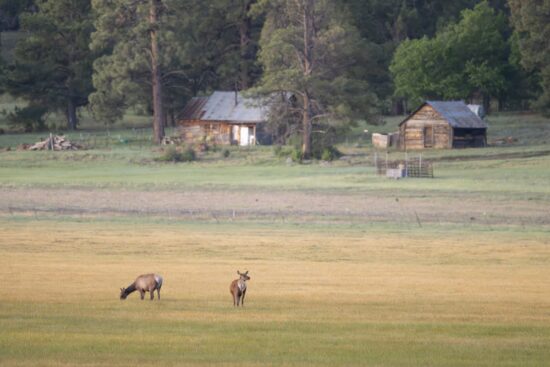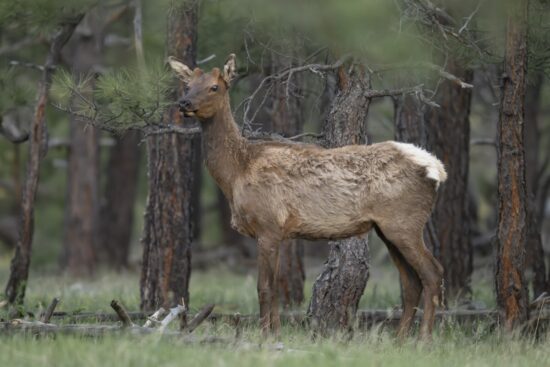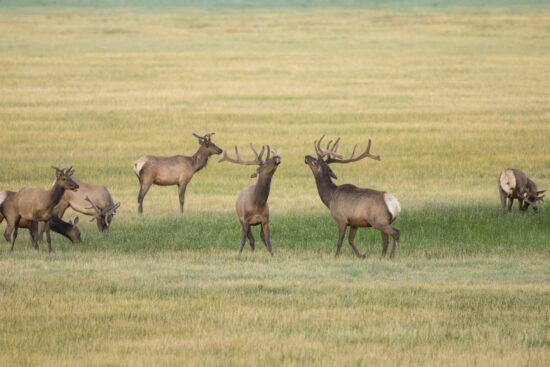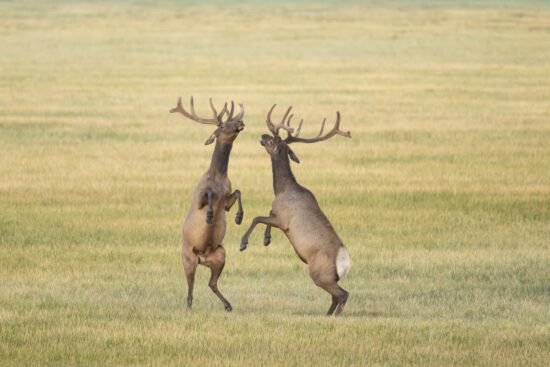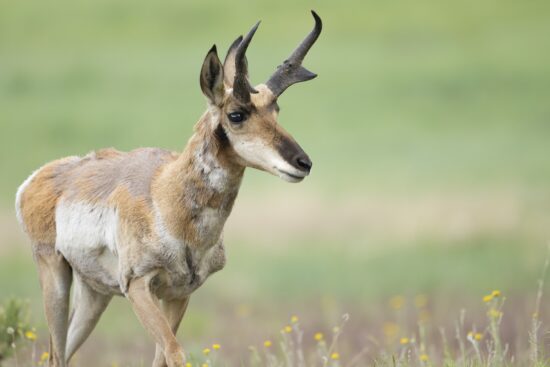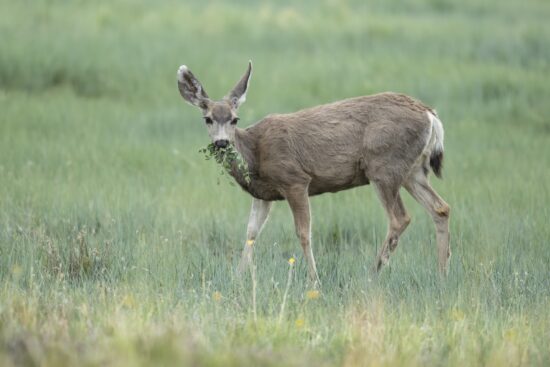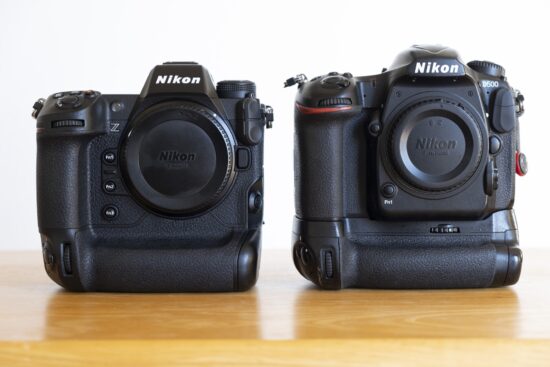
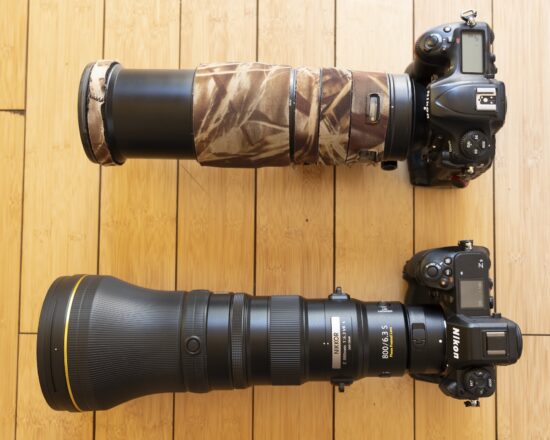
30 days with the Nikon Z9 and Nikkor Z 800mm f/6.3 VR S lens by Bill Ferris – a wildlife/bird photographer in northern Arizona who recently upgraded from a Nikon D500/Nikkor 200-500 combo to a Nikon Z9/Nikkor 800mm PF system:

A coyote and newborn elk calf face off in a northern Arizona meadow on a summer’s day. (Nikon Z9 with 800mm PF at f/6.3, 1/800, ISO 320)
OK, full disclosure…it’s not been exactly 30 days. Federal Express delivered the camera, lens and accessories on May 7. Today’s date is June 10 and my most recent shoot with the new kit was yesterday, June 9. But what’s a couple of days amongst friends?
Before getting into my early impressions, I want to share the backstory on the photography I do and what led me to purchasing this system. I’m a wildlife and bird photographer living in Flagstaff, Arizona. Phoenix and Tucson are farther south in the desert where the high will be about 110 °F (43 °C) today. Flagstaff is on the Colorado Plateau at 7,000 feet (2133 meters) elevation. A typical June day has a high in the mid-eighties.
I’m also a long time Nikon user. Since 2018, I have been shooting with a Nikon D500 and Nikkor 200-500mm f/5.6E VR. I’m on my second copy of the 200-500. Nikon replaced the first under warranty, due to multiple service trips to repair a failed zoom mechanism.
That combo has served me, well. The D500 has the DX version of the D5’s 20 MP sensor and autofocus system, a 10 fps burst rate, an effectively bottomless buffer, professional build quality and controls. The 200-500 is a consumer zoom lens. It was released in the fall of 2015 as Nikon’s response to the Tamron and Sigma 150-600mm f/5-6.3 zoom lenses that were popular with a growing segment who enjoy nature and wildlife photography.
Being a photographer, I naturally found shortcomings in my gear. The first to emerge was the marginal low-light performance of the kit. With a maximum aperture of f/5.6, the 200-500 was affordable, sharp wide open but challenged in the light-gathering department. Exotic prime and zoom lenses in the same focal length range are all at least a full stop faster. The D500 was equally challenged in that area. It’s APS-C sensor captures one-stop less light than a full-frame body working with the same exposure.
I could navigate around these issues. I worked hard at improving my field craft and getting closer to subjects without being a disturbance to them. The closer you are, the better an animal fills the frame and the more light your camera captures from them. I invested in a quality Benro tripod and gimbal head system. Combined with the 200-500’s excellent vibration reduction (VR), I was able to use shutter speeds as slow as 1/30-second and still freeze the movement of grazing animals in early morning twilight. Wide open at 1/30 is a recipe for sucking as much available light as possible from an early morning scene.
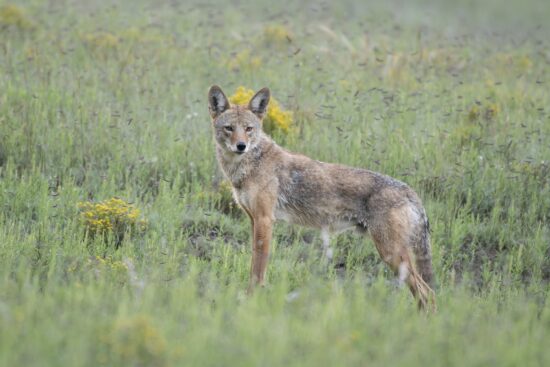
A dew-soaked coyote pauses briefly at the edge of the Grass Flat Tank meadow. (Nikon D500 w/ Nikkor 200-500mm f/5.6E at 500mm, f/5.6, 1/30, ISO 1600)
Another nagging issue was the ubiquitous mirror blackout of the D500. It’s an SLR body and every time the mirror slaps up and out of the light path to allow the sensor to make an exposure, the image in the optical viewfinder goes dark. This isn’t an issue when photographing static subjects. However, mirror blackout makes tracking a bird in-flight or fast-moving wildlife a test of, shall we say, one’s psychic gifts.
What ended up being my biggest complaint was the sound of the D500 during a shutter actuation. It’s a loud camera. During most bird or wildlife shoots, that sound would get the attention of a raptor soaring overhead, or elk, pronghorn or deer grazing near where I was set up. Birds and animals were seldom startled enough to make a hasty escape but they would respond as most animals do in that situation. They’d put some distance between themselves and the weird sound. Countless good photo ops were brought to a screeching halt when the clack-clack-clack of the D500 started echoing through the forest.
When Nikon announced development of their mirrorless Z-mount cameras just a couple of months after I bought the D500, I took notice but was only mildly interested. I assumed the first-generation Z bodies would be works in progress and that Nikon would need a couple of years to work the bugs out of the system. In the back of my mind, I was hoping for a Z-mount version of the D500 by about 2022. When the flagship Z9 was announced in late 2021, I started paying close attention to the goings on in the Zcosystem.
Rumors about a Z8 being developed and ready for introduction in the spring of 2023 combined with rumors that the long-anticipated 180-600mm Z-mount zoom was also soon to be announced had visions of a Z900 dancing in my head. The 180-600 would be the perfect lens to pair with an APS-C sports and action camera. Despite the rumor mill being quiet on a D500 replacement, I remained cautiously optimistic.
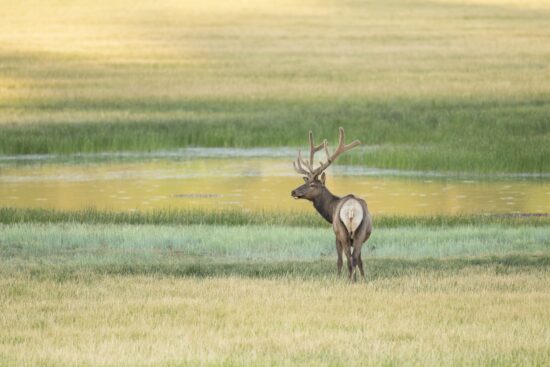
A bull elk scans the far side of the meadow as the summer sun makes first contact with the grass. (Nikon Z9 with Nikkor 800mm PF at f/6.3, 1/400, ISO 1600)
The D500 had been a surprise announcement at the D5’s introduction in January 2016. Would Nikon borrow a page from that book and make a surprise camera introduction with the Z8 or their new consumer zoom?
No. They did not. While feeling a bit disappointed, I was not ready to leave the Nikon biosphere. I’d been a Nikon shooter for 30 years. I was still enjoying every minute I could scrounge around work and family commitments to be out with the gear I did have. Most important, I was making good photos.
2023 was a significant year for me. I decided to retire from a 35-year career in television and video production. That came with a bit of a windfall from accumulated paid leave time my employer bought back. I decided to invest part of that in a new camera system. I wanted something that could serve me well for the next decade.
I quickly narrowed the list of options to two cameras: the Nikon Z9 and the Z8. The Z8 has a lot going for it, including the Z9’s 45 MP stacked, back-side illuminated (BSI) sensor, its autofocus system, burst rate, and many other features. Reaching out to a few photographers whose opinions I value, I shared the basics of what and how I like to shoot and asked their thoughts on which of the two cameras would be the best fit.
The unanimous response was the Z8 is an exceptionally capable camera but the Z9 tends to get new features first, is more customizable and has a built-in vertical grip. I had been using my D500 with Nikon’s MB-D17 battery grip from day one. Candidly, I’m not impressed with the accessory battery grip Nikon developed for the Z8. That made the decision pretty easy. I would go with the Z9. With that settled, I took on the question, which lens should I pair with the new camera?

Portrait of a northern Arizona pronghorn buck. (Nikon Z9 with Nikkor 800mm PF at f/6.3, 1/2000, ISO 500)
The D500/200-500 combo at full zoom makes a photo having a full-frame equivalent 750mm angle of view (AOV). A data mining run through my Lightroom Classic catalog revealed that 85% of my best photos with the D500 have been made with the zoom at 500mm. Given that I still do at least a bit of cropping with that system, I figured it was safe to say at least 90% of my portfolio images with the D500 had been made with a 750mm AOV. Armed with this information, I focused my search on lenses in the 600-800mm range.
Until about a month ago, I had never owned a flagship camera or a prime lens. I like zoom lenses. They’re flexible and can fully frame a subject whether near or far – well, not too far. Optically, consumer zooms have gotten to be quite sharp. They’re not light hogs but I had developed solid strategies for mitigating the impacts of that deficiency. Also, consumer zooms are priced right. They’re relatively affordable.
However, if I was going to invest in Nikon’s current flagship, I wanted to give serious consideration to getting a high-quality lens, a professional lens, an S-line lens.
It was December of 2021 when Nikon announced development of the 800mm f/6.3 VR S. This was to be their third phase Fresnel (PF) lens, joining 300mm f/4 PF and 500mm f/5.6 PF. Both of those F-mount primes had earned reputations as professional quality glass priced well-below their weight class. As the date of introduction drew near in early 2022, speculation was rampant as to what the price of the new 800mm prime would be.
The F-mount 800mm f/5.6 is a beast in so many ways…large, heavy, and priced north of $16,000. The buzz was that the new 800mm PF would be lighter and less expensive, but nobody knew by how much. A street price of $10,000 was the number I most frequently saw bandied about.
In April 2022 when the 800mm f/6.3 VR S was introduced, I think it’s fair to say people were shocked at the introductory price of $6,500. That’s less than half the cost of its older sibling. The specs page also showed it would tip the scales at about half the weight of 800mm f/5.6. If the 800 PF continued the legacy of optical excellence established by its predecessors, it would arguably be the greatest value in Nikon’s growing and impressive lineup of professional telephoto lenses.
There was one reservation I had. I had resolved my concern that the new PF lens would be too long. Knowing the system I’d been using the last six years was almost always at an effective 750mm focal length eased that worry. The one remaining reservation was about the f/6.3 maximum aperture. My 200-500 is f/5.6 when wide open. I’d be giving up a bit of speed when it comes to exposure.
But – there’s always a but – a lens’s f-stop isn’t the truest indicator of its low-light performance. The spec that tells you what you need to know on that front is its entrance pupil diameter. The entrance pupil is the opening through which light passes enroute to the sensor. It’s the lens’s aperture. The larger that opening, the more light the lens collects from the subject. The f-stop tells you how to calculate the diameter of the entrance pupil. Divide the focal length by the f-number to get the answer.
The Nikkor 200-500mm f/5.6E VR has a (500mm/5.6=89.28mm) 89mm diameter entrance pupil. The 800mm f/6.3 VR S has a (800mm/6.3=126.98mm) 127mm entrance pupil. That gives the 800 PF an aperture 43% larger in diameter than the F-mount zoom. The surface area of that opening is (1.43^2=2.04) just over 200% that of the 200-500’s. In short, the 800mm PF at f/6.3 collects twice as much light from a bird or elk as the 200-500mm f/5.6E. In fact, the 800mm ranks behind only the 600mm f/4 (150mm entrance pupil) and 400mm f/2.8 (143mm) as the best low-light long lenses in the Z-mount lineup.
Test images made to compare the low-light performance of the Nikon D500 and Z9. The same f-stop and ISO settings were used. Shutter speeds were adjusted to ensure the same exposure in the variable light:
I’d be gaining an additional stop of light just from the lens. Combine that with the additional stop of light the Z9 captures when working with the same exposure as the D500 and the upgrade path I chose – Nikon Z9 with Nikkor 800mm PF – would be expensive but would also address every priority need on my checklist. The Z system would deliver a skosh more reach than my current kit, have better low-light and autofocus performance, twice the burst rate, a deep enough buffer, flagship build quality and controls, and would enable silent shooting. When Nikon offered special pricing on their products in May 2024, I placed an order. The new gear arrived on May 7.
The first couple of days were devoted to getting to know the new kit. As complex as the Nikon DSLR’s I’ve used since the early 2000s had been, the Z9 is on a different level. The D500 user manual is 400 pages long. The Z9 reference guide is over 1,000 pages in length. Much of the complexity of the Z9 is hidden beneath the surface. We’ll get to those features in a bit.
Physically, the Z9 is similar in size to my D500 paired with its battery grip. The Z9 weighs in at 1.38kg with a battery and two CF Express cards. The D500 tips the scale at 1.24kg with the grip, two batteries, an XQD and SD card. The D500 is a bit taller. Both are the same width. The Z9 is bit thicker in depth. While the 145-gram weight difference (5.1 oz.) can be felt in the hands, the Z9 doesn’t feel overly large. It feels tankier; more solidly built.
The lenses with feet, hoods and camo wraps, weigh in at 2.73kg (800 PF) and 2.61kg (200-500) respectively. That’s a 120g or 4.3 oz. difference. Without hoods, they are 375mm (800 PF) and 330mm (200-500) in length, respectively. That’s a difference of 25mm or about an inch. Adding the hoods, the 800mm f/6.3 VR S is 100mm or 3.9 inches longer than the consumer zoom.
The two kits taken as a whole weigh in at 4.09kg (Z9 w/ 800 PF) and 3.80kg (D500 w/ 200-500). Those measurements include the lens feet, hoods and LensCoat camouflage wraps. The 292g difference works out to about 10 ounces. While a significant difference, it’s not as substantial as one might expect given the mental picture of an APS-C camera and 500mm lens being compared with a full-frame flagship body and 800mm prime lens.
Both systems have Nikon’s professional user interface. The common features on the top panel include a mode turret to the left of the viewfinder. An LCD information display is to the right of the viewfinder with power/shutter release controls, video record, ISO, and exposure compensation buttons clustered atop the grip.
Both cameras have front and rear command dials positioned where a longtime Nikon owner would expect. The AF-ON and multi-selector thumb sticks are – again – in familiar positions. The delete button is immediately to the left of the viewfinder eyepieces in both instances. A directional pad is located in roughly the same position on the back panel of both cameras. As a result, basic operation of turning the Z9 on, manually adjusting shutter speed and f-stop, selecting an ISO, positioning the autofocus area, initiating autofocus and making a photo are as instinctively natural, right from the start, as they’ve been for the last six years with my D500.
That’s where things start to diverge. Being a mirrorless camera, the Z9’s electronic viewfinder (EVF) provides a video display of the scene being photographed. It’s a what-you-see-is-what-you-get (WYSIWYG) preview of the photo. While not a perfect representation of that image, right out the box at default settings it’s very close.
The information displayed in the EVF includes the basics shown below the D500’s optical viewfinder (OVF) image. These include metering mode, f-stop, shutter speed, ISO, and the in-camera lightness meter. The Z9 also displays the exposure mode, the number of shots remaining on the card, and battery life at the bottom of the EVF display. Information presented above the scene display includes burst, autofocus, and white balance modes, image quality, picture control, and image area. The Z9 can also be configured to include an inset histogram at bottom right in the scene display. It’s also able to show a dark scene with a lightness matching that of the selected ISO.
As a wildlife photographer who is often out before sunrise and working in low light, I maintain light discipline to keep my presence unknown to the animals. Image and menu viewing in the EVF is a valued option. This, of course, is not an option in the D500’s OVF.
The most important feature to me and the wildlife & bird photography I do, is the ability to shoot silently. More precisely, to shoot quietly enough that I can hear the camera operating but the animals I photograph cannot. The Z9 has no mechanical shutter. It’s fully electronic. As a result, the camera can be completely silent when making a photo. Personally, I’ve grown accustomed during more than 30 years as a photographer to associate the sound of a shutter actuation with making a photo. Going through the menu options, I was pleased to see a “Camera Sounds” section that includes prerecorded shutter sounds among the features. A volume setting of 1 for the shutter sound is loud enough to provide an aural que that a photo is being made but quiet enough that nothing outside my photo hide can hear it. This has been a game-changer.
That phrase may be overused in many circles but it applies, here. The sound of the D500’s shutter activation and the mirror slapping up and down has ended far too many productive photo outings. In the first month of ownership of the Z9, I have yet to have an animal become aware of my presence or the camera’s through sound. I am routinely treated to close encounters with subjects grazing near the portable hide I’m in. They can see the enclosure but have no idea a person is inside. Deer, pronghorn, elk…these are animals that instinctively keep as much distance between themselves and people as possible. We hunt them. They see us as predators. But if they can’t see, hear or smell us, they go about their normal routine as if we aren’t even there.
Another feature I’ve come to appreciate – I won’t’ call this one a game-changer – is the blackout-free view during a high-speed burst. The mirror blackout in the D500 OVF is really distracting. It makes tracking birds in-flight a challenge, especially as a bird comes nearer and fills most of the frame. The Z9 is able to push data from the sensor so quickly that there is no blackout between frames in a burst. You’re able to maintain constant visual focus on the subject and adjust composition as the animal moves. It’s a true…nope, said I wouldn’t do it.
The Z9 autofocus system is remarkable. Both animal and bird eye detect are effective at recognizing an animal in the frame and, when filling enough of the frame in decent light, finding and focusing on an eye. The camera does struggle a bit to identify an eye on an animal with a substantial set of antlers or horns. I’ve noticed this when photographing pronghorn bucks and elk bulls. A low light level may also be a factor as eye detection seems less reliable in twilight conditions. That’s my initial impression.
It’s fascinating to watch the subject detection mode at work. In good light when a face is toward the camera, a small square will hover above the nearest eye and follow it as the subject moves within the frame. If the face goes into shadow or becomes obstructed, that tiny square increases gradually in size looking for a different eye or the face. If the camera finds neither, the box continues to increase in size until the camera recognizes the main body of the subject. That’s where it will focus. When an eye becomes visible again, the system quickly isolates and frames the eye in the tight square, acquires and tracks focus on that feature.
A recent feature released by Nikon through a firmware update is the ability to assign a custom list of autofocus modes to a function button and to cycle through that list simply by tapping the button. The Z9 comes with a lengthy selection of autofocus modes, including AF-S or AF-C, single point, dynamic (S, M, L), wide area (S, L), wide area (Custom 1, Custom 2), auto area and 3D. You can cycle through the full list or a custom list of options simply by repeatedly tapping the selected button. I’ve assigned this feature to the video record button.
The EVF and LCD image displays are customizable. Set up in high performance mode, the EVF/LCD display refreshes at 120 fps and the display’s fluidity improves substantially. The camera can be configured so just one of the two displays is operational or to allow switching of the display between the EVF and LCD. I won’t attempt to present an exhaustive list of all the tools and customizations at your disposal. I’ll just leave it at this: the list is long.
I’ve been using the banks system in my D500 for six years and was both pleased and a bit disappointed that the banks system is essentially the same in the Z9. That similarity made the process of creating my four pairings of shooting and custom settings banks fairly straightforward. There are, of course, more options from which to choose in the Z9’s menu. However, it has been my opinion based on personal experience and comments I’ve seen from other Nikon photographers that the banks system is not intuitive; not to most people. Nikon has an opportunity with the Z line of cameras and lenses to rethink the tools made available to allow photographers to custom configure their kit. They’ve not taken advantage of that and it’s a shame.
May 9 was my first outing with the Z9 and 800mm f/6.3 prime. Including that first shoot, I’ve been out 22 times with the new gear to photograph wildlife or birds. I’ll sprinkle some sample photos in with my thoughts on how the kit is performing. All the images I’ll share were processed to taste in Lightroom Classic (LrC) and finished by being run through LrC’s AI noise reduction tool.
I’ve taken the new kit to a few of my favorite bird and wildlife photography locations. One, is the Mormon Lake overlook. The overlook is an elevated plateau along the east side of Mormon Lake in northern Arizona. When the wind is coming from the southwest, raptors like to ride the breeze along the rim while searching for squirrels, chipmunks, voles, reptiles and other tasty morsels. Red-tailed hawks and American kestrels are year-round residents. Bald eagles, northern harriers, falcons and a variety of hawks species are seasonal lodgers. Songbirds are common, as well.
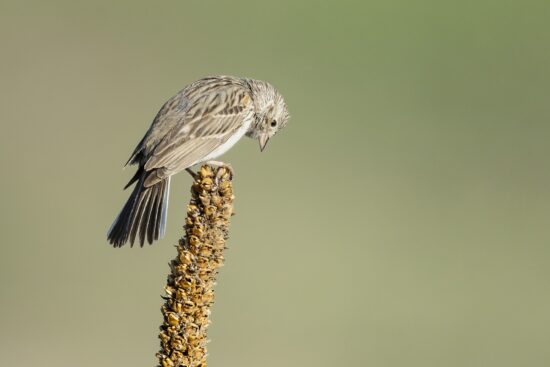
A vesper sparrow sits perched atop a common mullein at the Mornon Lake Overlook. (Nikon Z9 with 800mm PF at f/6.3, 1/3200, ISO 800)
An almost year-round resident of the overlook is the turkey vulture. These large carrion eaters hunt along the Lake Mary Rd corridor where outdoor enthusiasts in the cars, trucks and RVs regularly dole out fresh servings of roadkill. I like how adding just a touch of clarity in LrC helps a partly cloudy sky pop and add life to an image. Turkey vultures are curious birds. They’re genuinely interested in people. They’ll often orbit where I’m set up a few times before continuing their rounds along the rim.
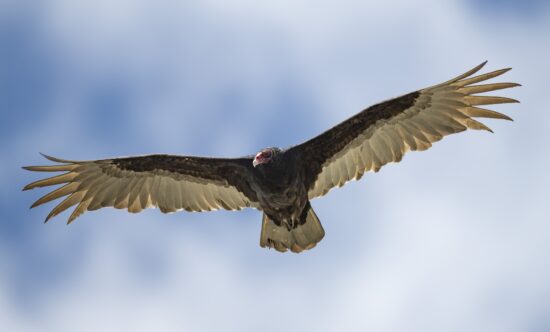
A turkey vulture patrols the sky above Mormon Lake in northern Arizona. (Nikon Z9 with 800mm PF at f/6.3, 1/2500, ISO 800)
Northern Arizona is home to the Coconino National Forest, more than 1.8 million acres ranging in elevation from 2,600 feet in the Verde Valley to 12,633 feet atop Mt. Humphries, the tallest mountain in the state. The forest is dominated by Ponderosa pine woodlands at elevations above 4,500 feet on the Colorado Plateau. I like to visit meadows and forest clearings where elk, pronghorn, deer and the occasional coyote will come to graze or hunt.
The 800mm f/6.3 VR S is wicked sharp. Used with the Z9, the amount of detail in a photo is impressive. My reaction is influenced by what I’m coming from; a 20MP camera used with a consumer zoom. As good as the 200-500 is – tack sharp is the phrase I’ve used to describe photos made at 500mm f/5.6 – the S-line 800mm is in another class. It’s not that the consumer zoom is a bad lens. It’s not. If a person isn’t able to make a quality image with that lens, they need to look in the mirror to find the reason why. But the 800 PF just delivers a higher level of performance.
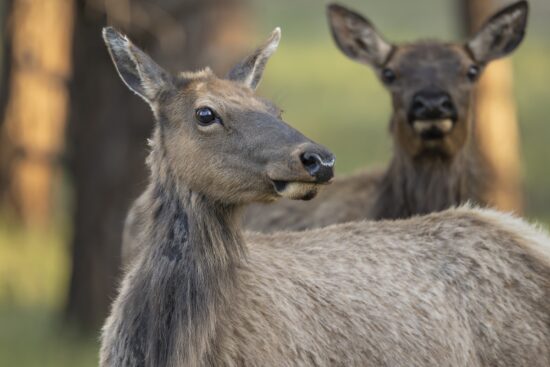
Elk cows pose for a photographer in the Coconino National Forest. (Nikon Z9 with Nikkor 800mm PF at f/6.3, 1/250, ISO 1600)
The OEM tripod foot that comes with the lens is a long-running disappointment to many Nikon users. If you use a tripod, it’s likely the tripod head is compatible with Arca type plates. Why Nikon does not ship their professional long lenses with Arca compatible feet is beyond me. It’s the industry standard and Nikon should design S-line products to be compatible with that standard.
The 800mm PF comes with a collection of controls, including focus range limiter and auto/manual focus switches along the left side towards the back. There’s also a 46mm drop-in filter holder atop the lens near the mount. I’ve not had a need to use any filters. A memory set button on the right side allows you to store a focus distance for immediate recall. Four assignable function buttons are positioned at 90-degree intervals around the lens just in front of the assignable control ring. (This ring’s default setting is to adjust aperture.) I use these to recall the stored focus setting. However, the placement of these buttons also happens to be where my left hand naturally rests atop the lens when the camera is on a gimbal head or beneath the lens when supporting it for handheld photography. As a result, I’m often inadvertently pressing one of the four function buttons while shooting. It’s a minor annoyance but I’ve not come up with a better configuration in my short time with the lens.
When I’m out for an early morning wildlife shoot, I’m on the road at zero dark-thirty to be in place and set up in my portable hide about 30 minutes before sunrise. With the camera mounted to the gimbal head tripod, I power it on and check the settings in the EVF. During my last morning shoot on June 9, I started at f/6.3, 1/50-second, ISO 12800 with a white balance of about 8330 Kelvins. (I manually set white balance as a strategy to keep my head in the game during long stretches between photo ops.) I set focus on the treetops profiled against the twilight sky and used my binoculars to scan the area for animal activity. One of the keys to making usable images in low-light is to fill the frame with the composition. Cropping takes an image that was made with minimal light and tosses some of those valuable photons aside. If the animals are on the other side of the meadow, I’ll look for interesting compositions of multiple animals or that incorporate landmarks and other elements that contribute to telling a story.
Here’s a photo made with the Z9 & 800mm PF at f/6.3, 1/50, ISO 12800. The elk were probably 150 meters distant for this photo, far enough that they wouldn’t be shown in rich detail even in optimal light. In twilight conditions they are recognizable by their form but close inspection won’t reveal much additional detail. It’s an image worthy of sharing on social media but would not be a candidate for printing or publication.
This photo was also made in early morning light at ISO 12800. However, this subject was close enough to fill the frame. The elk cooperated nicely by standing still just long enough so a 1/100-second shutter speed could freeze any residual movement. It’s surprisingly detailed given the paucity of light available to make the image. There’s detail in the elk’s face and in the winter coat that’s in the process of being shed. While not an image I would print as a wall-hanger, it’s absolutely good enough to display at full resolution in an online gallery.
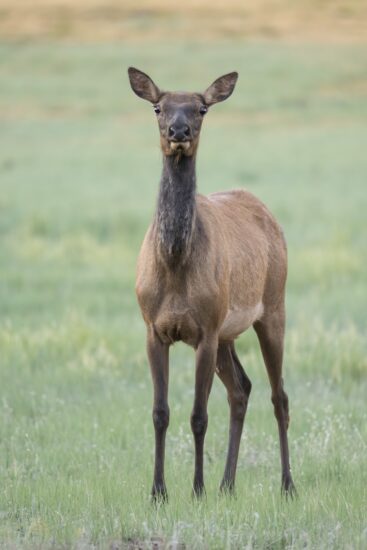
And elk cow scans the edge of the forest during it’s early morning graze in a northern Arizona meadow.
As the morning sky continues to brighten and throw more light on the meadow, the Z9 and 800mm PF are starting to show their suff. In this portrait of an elk cow made at f/6.3, 1/80, ISO 6400, we see clear & crisp focus on the face and eyes with very good detail in the animal’s face. The animal eye detect autofocus really nailed it with this shot.
By ten minutes after sunrise, the Sun has not yet cleared the trees to shine directly on the meadow, but there is enough ambient light to use a shutter speed that will freeze action while delivering an exposure to the sensor that’s compatible with ISO 3200. Here, are two big bull elk sparring with each other. Reared up on their hind legs, their noses are nearly four meters off the ground. The combatants have attracted a crowd of onlookers; mostly younger males who aren’t yet ready to compete for herd dominance. The exposure settings used for both images were f/6.3, 1/320.
This photo was made forty minutes after sunrise on an overcast day. Conditions are perfect as the soft luxurious light paints everything with an even illumination. North American pronghorn are among the fastest land animals on the planet; second only to the cheetah. The settings for this portrait are f/6.3, 1/400, ISO 2000. The animal is close enough that the lower legs are outside the frame.
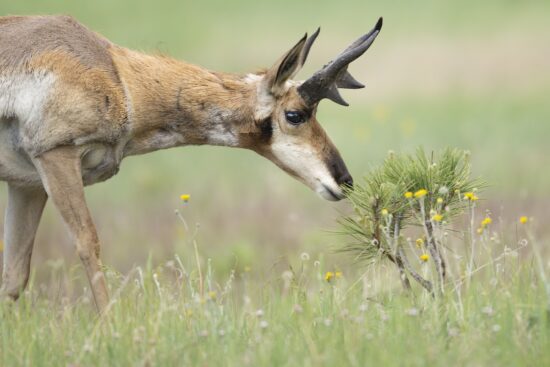
A pronghorn buck chekcs the sent left by another pronghorn on a Ponderosa pine tree seedling at the edge of the Coconino Natoinal Forest.
Here’s another shot made at the same settings with just the upper body in the frame. Pronghorn bucks mark tree seedlings with their scent as a way of letting females and other males know they’re in the area. This buck spent several minutes investigating this seedling Ponderosa pine tree.
When composing a shot like this, it’s best not to cutoff the animal right at a joint. It looks weird, like the appendage has been amputated or they’ve been severed at the neck or waist. Frame a skosh above or below the joint to achieve a more natural look. Just as in fashion or portraiture photography, it’s not necessary to show the entire animal in every photo. Mix it up and, when using a long lens like the 800 PF, don’t be afraid to get creative with your framing and isolate what’s most striking to you in that moment.
By 45 minutes to an hour after sunrise, the sky is still overcast but the ambient light level allows a shutter speed of 1/800 and an ISO of 1600 with the 800mm PF wide open. These mule deer came within 20 to 30 meters of where I was set up. I freed the side window flap, extended the lens through the opening and held it in my hands with both elbows resting on my knees to make these photos. I was shooting like this for twenty minutes with no difficulty keeping the camera and lens reasonably steady. That’s how manageable the weight is. Lens VR was active in sport mode.
One of the challenges of working with such a long focal length is capturing shots with more than one animal in the frame. I really enjoyed working this deer herd, making individual portraits but also taking advantage of opportunities to frame two or three animals together. The subtle hues of the wildflowers in the foreground added a nice colorful touch to the neutrally hued mule deer.
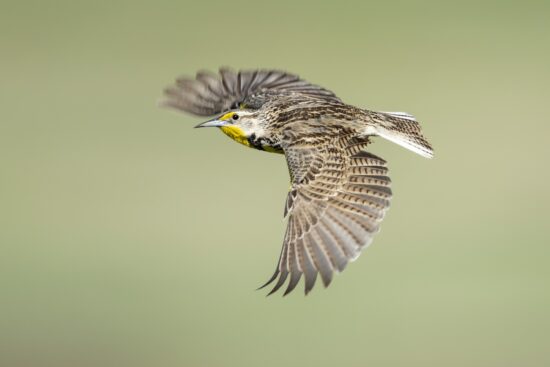
A western meadowlark in-flight along the east rim overlooking Mormon Lake, AZ. (Nikon Z9 with Nikkor 800mm PF at f/6.3, 1/2000, ISO 50)
This is one of the few good photos I’ve ever made of a western meadowlark in-flight. I’ve many nice compositions of perched meadowlarks but catching one in-flight was a welcome reward from this outing.
The Z9’s bird eye detect has worked impressively well in my few outings. The no-blackout view in the EVF is such a nice change of pace from the D500. Mirror blackout was a real distraction and made it difficult to keep birds in the frame when they got really close. That’s simply no longer an issue with the Z9.
I’m used to seeing and photographing western bluebirds in the Lower Lake Mary lakebed. During this shoot, I managed to capture some frames of a mountain bluebird. Here, we see the bird perched on a tree stump in the lakebed. It’s preening and not bothered in the least by the photographer quietly snapping away from his shaded position beneath the branches of a nearby Ponderosa pine.
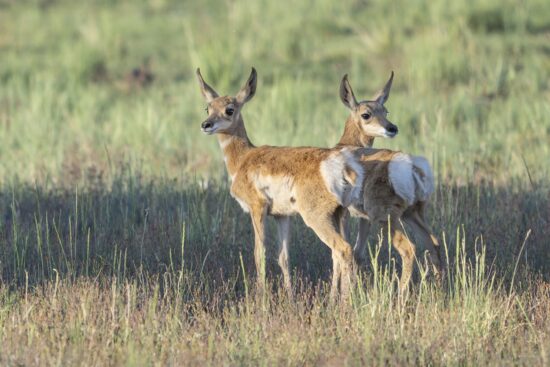
Pronghorn fawns keep an eye open for unwelcome visitors to a northern Arizona clearing while waiting for the mom. (Nikon Z9 with Nikkor 800mm PF at f/6.3, 1/1000, ISO 800)
In the month I’ve had with the Nikon Z9 and the Nikkor 800mm f/6.3 VR S, I’ve gotten to know both well enough to be comfortable using them in the field. I fully expect to continue making new discoveries about their capabilities and limitations over the next year or so as my outings present opportunities to explore deeper within the menus.
As of today, roughly one month into owning and using this system, I can say it has met every expectation. The Z9 performs like one would expect from a flagship. It exceeds my D500 in almost every conceivable way. If there is one nit I would pick, it’s that the Z9 can go through batteries with a hunger. I’ve recently made a couple of adjustments to my power management settings in the menu and am seeing improved battery life. It’s not as frugal as the D500 but I’ve also not been in a situation where two batteries hasn’t gotten me through a long, productive day.
That aside, from autofocus, burst rate and buffer to controls, user interface and build quality, the Z9 simply excels. It is, without question, the best camera I have ever owned.
The 800mm f/6.3 VR S is another stellar performer. It’s snappy to come to focus in good light, sharp enough to cut glass with the images it puts on the sensor and performs very well in low-light situations. It is fairly described as a niche optic. In Arizona where birds and animals are often seen at distance and across wide open spaces, a lens of this length will reliably meet a photographer’s needs without limiting your options solely to portraits, close ups and detail shots. The lens is deceptively light and well-balanced for its size.
I’m so glad I made this decision.
If you have an interesting idea for a guest post, please contact me here.


